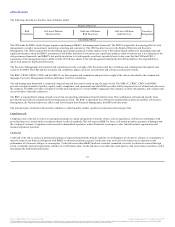BB&T 2014 Annual Report Download - page 71
Download and view the complete annual report
Please find page 71 of the 2014 BB&T annual report below. You can navigate through the pages in the report by either clicking on the pages listed below, or by using the keyword search tool below to find specific information within the annual report.
Table of Contents
BB&T’s other lending subsidiaries adhere to the same overall underwriting approach as the commercial and consumer lending portfolio and also utilize
automated credit scoring to assist with underwriting credit risk. The majority of these loans are relatively homogenous and no single loan is individually
significant in terms of its size and potential risk of loss. The majority of the loans are secured by real estate, automobiles, equipment or unearned insurance
premiums. As of December 31, 2014, included in the other lending subsidiaries portfolio are loans to nonprime borrowers of approximately $3.1 billion, or
2.5% of the total BB&T loan and lease portfolio.
Acquired from FDIC
BB&T’s loan portfolio includes $1.2 billion of loans acquired from the FDIC. This balance includes $654 million of loans that are covered by loss sharing
agreements and $561 million of loans that were formerly covered by loss sharing agreements. Refer to Note 4 “Loans and ACL” in the “Notes to
Consolidated Financial Statements” and to “Acquired from FDIC and FDIC Loss Share Receivable/Payable” section of “Management’s Discussion and
Analysis of Financial Condition and Results of Operations” in this report for additional disclosures related to loans acquired from the FDIC.
Liquidity risk
Liquidity risk is the risk to current or anticipated earnings or capital that BB&T will be unable to meet its obligations as they come due because of an
inability to liquidate assets or obtain adequate funding (funding liquidity risk) or that it cannot easily unwind or offset specific exposures without
significantly lowering market prices because of inadequate market depth or market disruptions (market liquidity risk).
Market risk
Market risk is the risk to current or anticipated earnings or capital arising from changes in the market value of portfolios, securities, or other financial
instruments. Market risk results from changes in the level, volatility or correlations among financial market rates or prices, including interest rates, foreign
exchange rates, equity prices, commodity prices or other relevant rates or prices.
Interest rate risk results from differences between the timing of rate changes and the timing of cash flows (re-pricing risk); from changing rate relationships
among different yield curves affecting bank activities (basis risk); from changing rate relationships across the spectrum of maturities (yield curve risk); and
from interest-related options embedded in bank products (options risk).
For additional information concerning BB&T’s management of market risk, see the “Market Risk Management” section of “Management’s Discussion and
Analysis of Financial Condition and Results of Operations” herein.
Operational risk
Operational risk is the risk to current or anticipated earnings or capital arising from inadequate or failed internal processes, people and systems or from
external events. This definition includes legal risk, which is the risk of loss arising from defective transactions, litigation or claims made, or the failure to
adequately protect company-owned assets.
Cybersecurity
In recent years, cybersecurity has gained prominence within the financial services industry due to increases in the quantity and sophistication of cyber
attacks, which include significant distributed denial-of-service attacks, malicious code and viruses and attempts to breach the security of systems, which, in
certain instances, have resulted in unauthorized access to customer account data.
BB&T has a number of complex information systems used for a variety of functions by customers, employees and vendors. In addition, third parties with
which BB&T does business or that facilitate business activities (e.g., vendors, exchanges, clearing houses, central depositories and financial intermediaries)
could also be sources of cybersecurity risk to BB&T, including with respect to breakdowns or failures of their systems, misconduct by the employees of such
parties, or cyber attacks which could affect their ability to deliver a product or service to BB&T.
70
Source: BB&T CORP, 10-K, February 25, 2015 Powered by Morningstar® Document Research℠
The information contained herein may not be copied, adapted or distributed and is not warranted to be accurate, complete or timely. The user assumes all risks for any damages or losses arising from any use of this information,
except to the extent such damages or losses cannot be limited or excluded by applicable law. Past financial performance is no guarantee of future results.
























